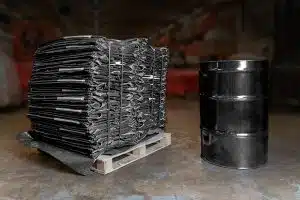 When it comes to storing or transporting hazardous materials, safety and compliance depend on one critical factor—the container. A 55 gallon hazmat drum or any other type of hazardous waste drum must meet strict standards to ensure it can safely contain potentially dangerous substances. This is where UN-rated drums come in. These containers are tested and certified according to international performance criteria designed to prevent leaks, spills, and accidents during storage or shipment.
When it comes to storing or transporting hazardous materials, safety and compliance depend on one critical factor—the container. A 55 gallon hazmat drum or any other type of hazardous waste drum must meet strict standards to ensure it can safely contain potentially dangerous substances. This is where UN-rated drums come in. These containers are tested and certified according to international performance criteria designed to prevent leaks, spills, and accidents during storage or shipment.
Understanding what an UN-rated drum is and why it matters helps facilities maintain compliance while ensuring safe handling of chemical and hazardous materials. Gorilla Drum provides durable, compliant solutions for industries that rely on hazmat drums and hazmat storage drums every day.
What Does “UN-Rated” Mean?
An UN-rated drum is a container that meets the United Nations performance standards for the safe transport of hazardous materials. These standards were developed to create global consistency, ensuring that hazardous waste is handled safely regardless of where it is shipped or stored.
Each UN rating represents a series of tests—such as drop, pressure, and leakproofness evaluations—that the container must pass before certification. These ratings confirm that the drum can safely contain specific types of hazardous materials under defined conditions.
For example, a UN-rated drum used to store flammable liquids or corrosive substances has been tested to withstand real-world handling stresses without failure. Whether you’re managing a chemical barrel or hazmat barrel, that certification provides assurance that the container meets international safety standards.
Why UN Ratings Are Important for Hazardous Materials
Facilities handling hazardous materials must comply with strict regulations enforced by organizations such as the U.S. Department of Transportation (DOT) and the Environmental Protection Agency (EPA). Using non-compliant containers can lead to serious violations, fines, and safety risks.
UN-rated hazmat drums ensure:
-
Compliance with both U.S. and international transport regulations
-
Safe containment of hazardous waste during handling and transit
-
Compatibility with specific waste classifications
-
Worker and environmental safety
Using UN-rated containers demonstrates due diligence and helps prevent costly incidents caused by leaks, contamination, or improper packaging.
Understanding UN Codes on Drums
Every UN-rated drum carries a specific code printed or embossed on the container. This code indicates key information about the drum’s construction, performance, and approved contents. A typical marking might look like this:
1H1/Y1.8/150/
Each part of this code tells you something about the drum:
-
The first digit and letter (such as 1H1) identify the type and material of the container.
-
The next letter and number (such as Y1.8) indicate the packing group and specific gravity rating.
-
The final number (150) refers to the maximum hydrostatic test pressure in kilopascals (kPa).
These markings make it easier to confirm whether a drum is suitable for your waste stream.
To better understand these markings and compliance requirements, visit the Understanding UN And DOT Ratings For Hazmat Drums resource for detailed guidance on how these standards work together.
Types of UN-Rated Hazmat Drums
UN-rated drums come in various materials and configurations to handle different waste types. Each design serves a specific purpose depending on the nature of the chemical or hazardous waste being stored.
Steel Drums
Steel drums are often used for flammable or high-temperature materials. They offer durability and resistance to impact but can be prone to corrosion if not properly lined.
Polyethylene Drums
Plastic or poly hazmat storage drums are best suited for corrosive materials like acids or bases. They provide chemical resistance and lightweight handling.
Composite Drums
These combine materials (such as plastic liners inside steel shells) for added strength and chemical compatibility.
Collapsible Drums
Modern alternatives like Gorilla Drum provide collapsible, lightweight options that meet UN standards while improving logistics, space efficiency, and handling safety.
UN Ratings and DOT Compliance
In the United States, UN ratings work alongside DOT regulations. While UN ratings verify a container’s ability to contain hazardous materials, DOT rules dictate how those materials must be packaged and transported.
That means even if a drum is UN-rated, it must also comply with DOT standards when used for transport. Containers must be labeled correctly, sealed properly, and inspected before shipment.
For facilities managing hazardous waste regularly, combining UN-rated and DOT-approved hazmat containers ensures full compliance with both sets of regulations.
Matching the Right Drum to the Waste
Selecting the right drum is not as simple as choosing the strongest container. The goal is to match the container’s material and design with the properties of the waste being stored.
Here are a few examples:
-
Corrosive waste should be placed in polyethylene or composite drums.
-
Flammable liquids require steel or specially rated metal containers.
-
Sludge or semi-solids may benefit from wide-open heads for easier access.
-
Reactive or volatile chemicals need tight, pressure-tested closures.
For detailed help selecting the appropriate container, read the Guide To Choosing The Right Hazmat Drums For Waste Storage, which explains compatibility, material options, and regulatory considerations.
How Gorilla Drum Improves Hazardous Material Handling
Traditional steel and plastic drums can be heavy, take up space, and require disposal or cleaning after use. Gorilla Drum offers a next-generation solution that improves both safety and efficiency.
Key benefits include:
-
Collapsible, lightweight construction for easy storage
-
UN and DOT compliance for hazardous waste transport
-
Reinforced zipper closures and durable polypropylene material
-
Compatibility with both liquid and solid waste streams
-
Reduced warehouse footprint compared to rigid drums
This innovative approach gives companies a safer, more efficient way to handle hazardous waste without compromising compliance.
Final Thoughts
An UN-rated drum is essential for safely storing and transporting hazardous materials. It provides assurance that the container meets rigorous international standards, protecting workers, the environment, and your facility’s regulatory standing.
When choosing the right hazmat drum, consider the material, waste type, and compliance requirements carefully. Gorilla Drum offers reliable, UN and DOT compliant solutions that make hazardous waste handling safer, easier, and more efficient.
To learn more about compliant storage and transport options for hazardous waste, call +1 800-758-8079.

